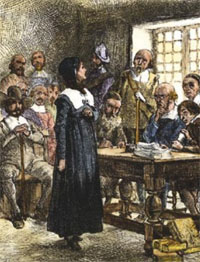国務省出版物
女性実力者の系譜-植民地時代「アン・マーベリー・ハッチンソン」

アン・ハッチンソンをマサチューセッツ湾植民地から追放する判決の様子を描いた木版画
「市民的自由と宗教的寛容の勇気ある唱道者」
1591年生まれ、1643年8月-9月頃死去
宗教の自由と言論の自由というアメリカの中核的な概念を最も早く提唱した人物の1人に、アン・マーベリー・ハッチンソンがいる。たいていの資料によると、彼女は英国国教会の反体制派の聖職者とその妻との間に英国で生まれ、1612年に商人のウィリアム・ハッチンソンと結婚して15人の子どもをもうけた。自分の宗教的信条をもっと自由に実践したいと切望した彼女は夫を説得し、自分が敬愛する牧師のジョン・コットンに従って、1634年に、現在のボストンにあたるマサチューセッツ湾植民地にやってきた。
そこから彼女の苦難が始まった。高い教育を受け、自分の本心を率直に語ることを恐れなかったアン・ハッチンソンは、信心深い女性たちを家に招いてコットン牧師の説教をじっくり考えさせる活動を始めた。彼女の評判が高くなると、その集まりにヘンリー・ベーン総督を含む男性も加わるようになった。伝統的な女性の行動範囲から逸脱したことに加え、植民地の牧師を非難し、「心に神の恩寵を持つ人は迷うことがない」と信じていたため、彼女は既成の教会と衝突することになった。教会は、マサチューセッツの新しい総督ジョン・ウィンスロップが「非常に弁舌さわやかで、男より大胆」と批判したこの女性の訴追に動いた。ハーバード大学教授ピーター・J・ゴメス師によると、彼女は裁判で、「植民地の男性説教師、神学者、判事の中でも最も優秀な人々を打ち負かした。」自分の信念を強力に弁護したにもかかわらず、彼女は1638年に破門・追放され、家族や信奉者とともにロードアイランドへ移住した。彼女は同植民地建設者の1人であり、後にアメリカ合衆国となるこの土地で、教会と国家を完全に分離し宗教の自由を確立した、最初の人物とみなされている。1642年に夫が亡くなった後、アン・ハッチンソンはニューヨーク州ロングアイランドに移った。悲惨なことに、彼女と、1人を除く彼女の子どもたち全員が、そこでインディアンの襲撃にあって殺された。
「市民的自由と宗教的寛容の勇気ある唱道者」という言葉が、彼女を称えてボストンに建立された彫像の土台に刻まれている。しかし、アン・ハッチンソンが与えた影響に対する最もふさわしい賛辞―彼女の理想が最終的に彼女の敵の理想に打ち勝った証拠―は、「連邦議会は、宗教を樹立したり、宗教の自由な実践を禁止したりする法律を制定してはならない」とする合衆国憲法修正第1条である。
*上記の日本語文書は参考のための仮翻訳で、正文は英文です。
Anne Marbury Hutchinson - American women help the new nation - Women of Influence
Courageous Exponent of Civil Liberty, Religious Toleration
(Born: 1591; Died: August/September 1643)
The core American concepts of freedom of religion and freedom of speech had one of their earliest advocates in Anne Marbury Hutchinson. Born in England to a dissenting Anglican clergyman and his wife, she married the merchant William Hutchinson in 1612 and bore him 15 children, according to most sources. Yearning for greater freedom to practice her religious beliefs, in 1634 she persuaded her husband to follow her beloved minister, John Cotton, to the Massachusetts Bay Colony, today's Boston.
Then her troubles began. Well-educated and not afraid to speak her mind, Anne Hutchinson began inviting devout women to her home to reflect on Cotton's sermons. As her reputation grew, the gatherings attracted men, too, including the governor, Henry Vane. In addition to stepping outside the bounds of conventional women's behavior, her denunciation of the colony's ministers and her belief that "he who has God's grace in his heart cannot go astray" set her at odds with the religious establishment. They moved to prosecute the woman Massachusetts's new governor, John Winthrop, criticized for having "a very voluble tongue, more bold than a man." According to Harvard professor Rev. Peter J. Gomes, at her trial "she bested the best of the Colony's male preachers, theologians, and magistrates." Despite her vigorous defense of her beliefs, she was excommunicated and banished in 1638, and moved with her family and other followers to Rhode Island. She is considered one of the founders of that colony, the first to establish complete separation of church and state and freedom of religion in what would become the United States. After her husband's death in 1642, Anne Hutchinson moved to Long Island, in New York. Tragically, she and all of her children save one were killed there in an Indian raid.
"Courageous Exponent of Civil Liberty and Religious Toleration" says the inscription at the bottom of a statue raised in her honor in Boston. But the most fitting tribute to Anne Hutchinson's influence – proof that her ideals ultimately prevailed over her opponents' – is the First Amendment to the U.S. Constitution: "Congress shall make no law respecting an establishment of religion, or prohibiting the free exercise thereof.”




